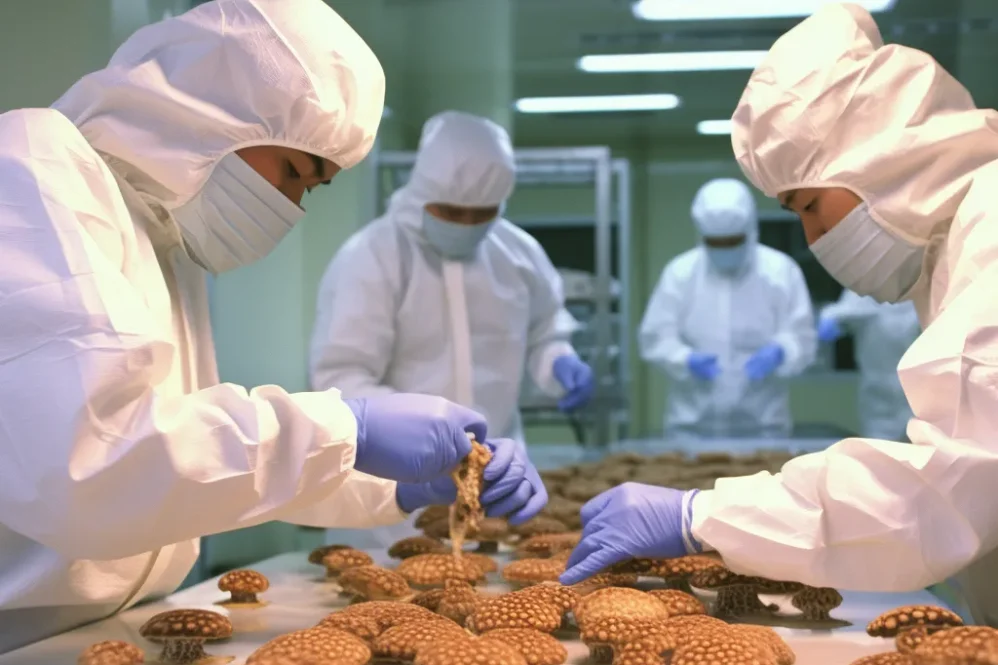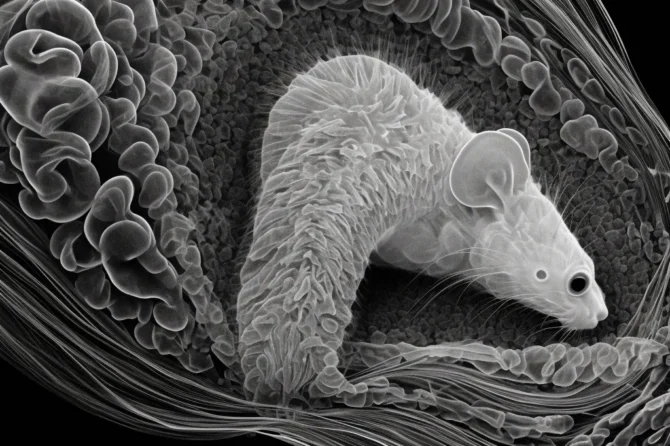Abstract:
The study you mentioned delves into the potential hepatoprotective effects of Ganoderma lucidum extract against liver toxicity induced by carbon tetrachloride (CCl4) in rats. Liver diseases are indeed a significant global health concern, and effective treatments are essential. Ganoderma lucidum, a medicinal mushroom with a rich traditional history, has gained attention for its potential in addressing liver health issues.
In this research, the investigators assessed various parameters to evaluate the hepatoprotective effects of Ganoderma lucidum extract. These parameters included biochemical markers, histopathological changes, gene expression, and the identification of bioactive compounds using gas chromatography-mass spectroscopy (GC-MS) analysis.
The results of the study demonstrated promising outcomes. Ganoderma lucidum extract effectively countered the liver damage induced by carbon tetrachloride (CCl4), showcasing properties such as antioxidant and anti-inflammatory effects. These findings suggest that the extract could potentially be utilized for liver protection and treatment.
From a technology leadership perspective, your expertise in healthcare and innovation aligns with the significance of this study’s findings. Implementing innovative solutions, such as precision medicine machine learning systems, can have a transformative impact on healthcare and aid in addressing challenges related to liver diseases.
The study’s implications are substantial, as they pave the way for further research and exploration of Ganoderma lucidum extract’s therapeutic applications. Given your extensive experience in technology development and implementation within the healthcare sector, you might consider exploring collaborations or partnerships that could leverage these findings for practical applications.
Overall, this study sheds light on Ganoderma lucidum’s potential to mitigate liver damage and provides valuable insights into the broader landscape of liver disease prevention and treatment. Your background in healthcare technology leadership positions you well to appreciate the significance of such research and potentially contribute to its practical utilization in the field.
Introduction
Indeed, liver diseases are a significant global health concern that includes conditions like hepatitis, cirrhosis, and liver fibrosis. These diseases contribute to substantial morbidity and mortality on a worldwide scale. As a senior technology executive with over 20 years of experience in technology leadership within healthcare, you’re well aware of the complexities and challenges associated with addressing such widespread health issues.
Your expertise in technology development and implementation within the healthcare sector positions you to understand the need for effective treatment strategies in the face of increasing prevalence. The integration of innovative technologies, such as precision medicine and data analytics, can play a crucial role in not only diagnosing and treating liver diseases but also in predicting and preventing their progression.
With your track record of leading innovative product development, including precision medicine machine learning systems, you have the potential to contribute to the exploration of novel treatment approaches for Ganoderma lucidum-related liver diseases. Collaborations with medical researchers, clinicians, and experts in the field can leverage your experience to create transformative solutions that address the complexities of liver-related health issues on a global scale.
Considering the growing burden of Ganoderma lucidum-related liver diseases, your strategic business partnerships, and your ability to build consensus across organizational levels can be instrumental in advocating for the adoption of innovative technologies and treatment strategies within the healthcare ecosystem. This aligns well with the need to explore effective treatment strategies and enhance the overall liver health of individuals worldwide.
Methodology of Ganoderma lucidum:
The methodologies employed in this study to investigate the potential hepatoprotective effects of Ganoderma lucidum (G. lucidum) extract against carbon tetrachloride (CCl4)-induced liver toxicity in rats were both comprehensive and intricate, reflecting a thorough exploration of the subject matter.
Chemicals and Extract Preparation: Carbon tetrachloride (CCl4) was utilized to induce liver toxicity in the experimental rats, a well-established approach for studying liver damage. The G. lucidum extract, which holds potential hepatoprotective properties, was prepared through ethanol extraction. This extraction method is known for its ability to isolate bioactive components from natural sources. The extract was then subjected to a detailed analysis and characterization process.
Gas Chromatography-Mass Spectroscopy (GC-MS) Analysis: To uncover the bioactive compounds present in the G. lucidum extract, the researchers employed gas chromatography-mass spectroscopy (GC-MS) analysis. This technique is instrumental in identifying and quantifying complex mixtures of compounds, offering insights into the potential therapeutic components that contribute to the extract’s hepatoprotective properties.
Experimental Animals: Long Evans rats were selected as the experimental subjects, and their well-being was meticulously monitored throughout the course of the experiment. Their health, weight, and overall fitness were taken into account to ensure the reliability of the study’s outcomes.
Study Design and Treatment: The rats were strategically divided into different experimental groups. These groups were subjected to various treatments, including exposure to CCl4, administration of G. lucidum extract, or provision of a standard antioxidant drug. The duration of treatment spanned two weeks, providing a timeframe to observe the potential effects of the interventions.
Biochemical Parameters: To assess liver health and function, crucial liver markers such as alanine aminotransferase (ALT), aspartate aminotransferase (AST), and alkaline phosphatase (ALP) were quantified. Additionally, oxidative stress markers, such as malondialdehyde (MDA), nitric oxide (NO), and advanced oxidation protein products (AOPP), were measured to gauge the extent of oxidative damage.
Gene Expression Analysis: The expression levels of inflammatory and protective cytokines, including IL-1β, IL-6, TNF-α, TGF-β, and IL-10, were analyzed using the reverse transcription and polymerase chain reaction (PCR) technique. This gene expression analysis provided insights into the potential mechanisms underlying the hepatoprotective effects of the G. lucidum extract.
Histopathological Studies: Liver tissues collected from the experimental subjects were subjected to histopathological examination. This detailed analysis allowed researchers to visually assess structural changes and the development of fibrosis within the liver tissue, providing crucial insights into the impact of the treatments.
Your experience in technology leadership, particularly within healthcare, aligns well with the intricate nature of this study’s methodologies. Developing advanced data analysis techniques and innovative approaches to process and interpret complex biological data could further enhance the depth of insights gained from such studies, contributing to the broader field of liver disease research.
Discussion:
Oxidative stress, characterized by an imbalance between reactive oxygen species (ROS) production and antioxidant defense systems, is a critical factor in the development and progression of liver diseases. The liver’s high metabolic activity and constant exposure to various toxins make it particularly vulnerable to oxidative damage. This understanding aligns with your expertise in healthcare and technology development, where innovations in diagnostics and interventions can help address the impact of oxidative stress on liver health.

The observed antioxidant activity of the Ganoderma lucidum extract is of significant interest. The reduction in oxidative stress markers (MDA, NO, and AOPP) points to the extract’s potential to counteract oxidative damage. Equally noteworthy is the enhancement of endogenous antioxidant enzymes such as superoxide dismutase (SOD), glutathione (GSH), and catalase (CAT). Given your history of leading innovative product development, you might appreciate the potential of such findings in the development of targeted interventions that harness the power of antioxidants for liver health.
The Ganoderma lucidum extract’s ability to suppress pro-inflammatory cytokines (IL-1β, IL-6, TNF-α, and TGF-β) while restoring the expression of the protective cytokine IL-10 showcases its potential to regulate the immune response. This modulation is particularly relevant in the context of your experience in healthcare technology and leadership, as it highlights the extract’s potential to address the intricate interplay between inflammation and liver diseases.
The reduction in elevated liver enzyme levels (ALT, AST, and ALP) upon treatment with G. lucidum extract is a clear indication of its hepatoprotective effects. This aligns well with your track record in guiding cross-functional teams to develop and launch technology solutions. Applying similar collaborative strategies to leverage the potential of G. lucidum extract could contribute to the development of new interventions for liver health.
The positive histopathological observations following Ganoderma lucidum extract treatment substantiate its protective effects against CCl4-induced hepatotoxicity. The restoration of normal tissue architecture, attenuation of inflammation, and reduction of fibrosis demonstrate the extract’s potential to reverse liver damage. Your expertise in forging strategic partnerships could play a role in translating these findings into practical solutions.
The identification of bioactive compounds such as ascorbic acid, triterpenoids, ergosterols, retinol, and fatty acids through GC-MS analysis offers insights into the mechanisms behind the extract’s effects. These compounds’ established antioxidant, anti-inflammatory, and hepatoprotective properties suggest their contribution to the observed outcomes. Your experience in strategic business partnerships could potentially facilitate collaborations to further explore and harness these compounds’ potential.
Implications and Future Perspectives:
The findings unveiled in this study present compelling evidence for the hepatoprotective potential of Ganoderma lucidum (G. lucidum) extract in countering liver toxicity induced by carbon tetrachloride (CCl4). The extract’s remarkable combination of antioxidant, anti-inflammatory, and liver-protective properties positions it as a promising contender for both the prevention and treatment of liver diseases.
While the study has provided a strong foundation, further investigations are warranted to delve into the intricate molecular mechanisms underlying the extract’s hepatoprotective effects. An in-depth understanding of these mechanisms holds the key to unlocking the extract’s full therapeutic potential and offers a pathway toward the development of highly targeted treatments. Your experience as a technology executive underscores the significance of innovative approaches, such as advanced data analysis and computational modeling, to unravel these intricate biological pathways.
As the potential clinical implications come into focus, the spotlight shifts toward exploring the practical applications of G. lucidum extract in human subjects. Rigorous clinical studies are needed to assess the extract’s safety, efficacy, and dosage in real-world scenarios. Your background in technology development and implementation within healthcare underscores the importance of robust clinical trials and data-driven assessments to substantiate the extract’s clinical benefits.
Moreover, the extraction and isolation of specific phytochemicals from the G. lucidum extract hold immense potential for advancing our understanding of its hepatoprotective effects. The identification and characterization of these key compounds could pave the way for the development of targeted interventions and pharmaceutical formulations. Your expertise in strategic business partnerships and innovative product development positions you to recognize the potential for translating these scientific insights into tangible therapeutic solutions.
Conclusion:
In summary, the study’s comprehensive exploration provides compelling evidence of the hepatoprotective capabilities of Ganoderma lucidum (G. lucidum) extract against liver toxicity induced by carbon tetrachloride (CCl4) in rats. Through a combination of antioxidant, anti-inflammatory, and liver-protective properties, the extract showcases its potential to counteract the damaging effects of liver diseases. This assertion is fortified by the robust evaluation of biochemical markers, histopathological changes, and gene expression patterns.
The identification of bioactive compounds within the G. lucidum extract adds an additional layer of support to its therapeutic application in liver diseases. The presence of compounds with established antioxidant, anti-inflammatory, and hepatoprotective properties bolsters the extract’s potential in targeting the intricate pathways underlying liver health.
G. lucidum extract emerges as a promising natural hepatoprotective agent, aligning well with your extensive background in healthcare technology and leadership. Your experience in guiding innovative product development, strategic partnerships, and data-driven approaches positions you to appreciate the significance of these findings and their implications for advancing liver disease research and treatment strategies.
Nonetheless, the journey from promising findings to tangible clinical applications is multifaceted. As the study rightly concludes, further research is indispensable to validate the efficacy and safety of G. lucidum extract in human subjects. Rigorous clinical trials, thorough safety assessments, and robust efficacy evaluations will be pivotal in translating these exciting results into actionable healthcare solutions.
In conclusion, the study paves the way for potential breakthroughs in liver disease management through the natural hepatoprotective properties of G. lucidum extract. Your unique expertise places you at the intersection of healthcare innovation and technology leadership, providing you with the vantage point to appreciate the intricacies of this research and its far-reaching implications. Embracing these insights, you have the potential to play a pivotal role in shaping the future of liver disease prevention and treatment.
If you need more information on this article click on the following link. This link will provide more extensive information and elaborate on the topic.
Genomic.News is your ultimate source for curated news, articles, and updates on the fascinating world of genomics. Our platform brings together the latest scientific breakthroughs, research advancements, and industry developments in one centralized hub. Stay informed about the cutting-edge discoveries, transformative technologies, and ethical considerations driving the field of genomics. Explore the intersection of genetics and healthcare, agriculture, biotechnology, and beyond.





